Overview | Detailed Itinerary | Travel Planner




Morocco Cultural Immersion Tour
April 12-25, 2024
Detailed Itinerary
April 10 and 11, Wednesday and Thursday.
We encourage tour participants to arrive a day or several days early to acclimate to the time zone changes and to have an opportunity to explore Casablanca. For those choosing to arrive early, we will provide sites of interest for self-touring Casablanca. Our past experience is that, closer to departure from home, tour participants correspond with one another, and arrange join ups.
April 12th, Friday.
Tour begins at breakfast, Friday, April 12th in Casablanca, which is also the ‘gateway’ arrival city airport.
After early breakfast, we drive to Chefchaouen, the ‘blue city’ of indigo lime washed buildings, a thrill to walk, and one of our favorites. Founded in 1471 by descendants of the Prophet Mohammed, Chefchaouen began as a refuge for Moorish and Jewish migrants escaping the Spanish Inquisition… a holy town, a walking town with eight mosques and some of the most vibrant weavers and weavings, and brilliant artisan workshops in all of Morocco.





We will visit Chefchaouen’s Muséé Ethnographique, overflowing with displays of pottery, embroidery, traditional dress, esoteric musical instruments, and painted wooden chests, all influenced by centuries of infusion from being adjacent to the Rif Mountain village cultures. Time for leisurely visiting shops, Andalusian-style gardens, galleries of Judaica artwork, and cafés.
April 13th, 14th, and 15th. Saturday, Sunday and Monday.
In the afternoon we drive to Fés, a World Heritage Site (UNESCO), founded in 789, the oldest ‘city’ in Africa, and surrounded by the verdant Middle Atlas Mountain forests. Our cultural historian guide with 40 years experience, Mohammed Salaheddin Lazrak, who will accompany us throughout our stay in Morocco, is a scholar speaking seven languages, and a walking encyclopedia of Judaica, Muslim, and Berber history and traditions. Our guide, Mohammed, will share his deep insights on charity and justice as they are infused within Islamic, Jewish, and Berber values, and the greater Moroccan culture.”






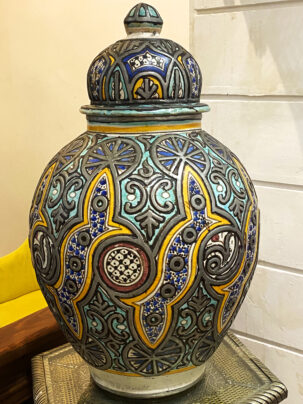


Mohammed was born in Fes’ holiest district, blocks away from Maimonides’ residence (1135-1204), the medieval Jewish philosopher, physician and rabbinic author known as Rabam and Ben Maimum among the Jews, and known as Ibn Mimum among the Muslim Fes community.
Bookending Maimonides’ Hebrew and Muslim appellations is a nod to the coexistence of both Abrahamic cultures.
During our three days in storied Fés, we will visit in depth the labyrinthine maze of souk markets. Artisan creations include woven carpets, copper and tinware, Berber ceramics, leatherwork and working leather tanneries, clothing, pastry delicacies, with every type of craft having its own district.
Side trips out of Fés will include a half-day visit to Volubilis, a World Heritage Site (UNESCO), the 104 acre, stunning 3rd Century B.C. Roman city. En route, we will stop in Meknés and visit the jaw-dropping 17th Century Mausoleum of Moulay Ismail, and tour the town, with its shops, fabric sellers, olive, dates, and citrus vendors, straw hat weavers, farmers of every description, and medieval donkeys transporting modern goods, as the preferred method of transport, a timeless, thousand-year-old signature.





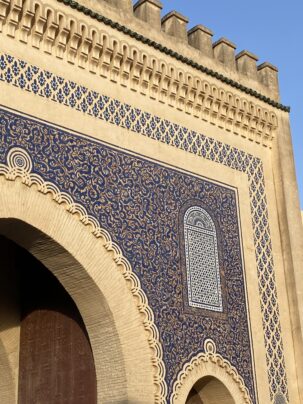


In Fés, we will be immersed in a place where all are called to prayer, “adhan“, emanating from the highly decorated minarets, five times a day – a reminder of the sacredness of life.
We will have time to walk the mellah, the historic Jewish quarter of Fés, relocated early in the 13th Century to be close to the palace, affording the Jewish community royal protection and security. Walking along Rue des Mérinides, we will experience the jewelry souk and various workshops in metalware: brass, bronze, copper, gold, and silver, and the 17th Century Synagogue, with its mikveh, ritual purification bath, its azara women’s gallery, and nearby sacred tombs in the Jewish cemetery.

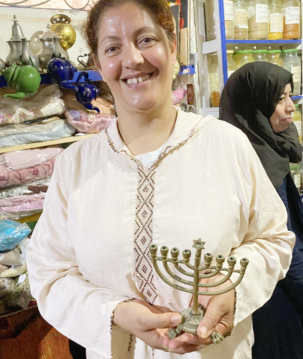




We will also participate in a Moroccan cooking school, mastering traditional Tajine dishes: vegan, vegetarian, and meat favorites, entreés, soups, and deserts, that we can replicate at home, and also take the timeless Hammam ritual bath and massage.
April 16th and 17th. Tuesday and Wednesday.
 Onward to Merzouga oasis in the Sahara, at the foothills of the Erg Chebbi Dunes, and two glorious nights in luxurious desert camp tents, surrounded by natural beauty and with multiverses of stars and ‘windows’ into intimate Berber culture. We will be serenaded by tribal musicians from the village of Khamlia, whose lineage reaches back to genuine original black African former slaves. At sunrise and dusk, sublime colors emerge out of the 800-foot-high dunes. Here, we encounter camel drivers and camel-ride tours of the dunes, which might include a visit to Dayet Srji Lake with its hundreds of pink flamingos, stork, and other migratory birds.
Onward to Merzouga oasis in the Sahara, at the foothills of the Erg Chebbi Dunes, and two glorious nights in luxurious desert camp tents, surrounded by natural beauty and with multiverses of stars and ‘windows’ into intimate Berber culture. We will be serenaded by tribal musicians from the village of Khamlia, whose lineage reaches back to genuine original black African former slaves. At sunrise and dusk, sublime colors emerge out of the 800-foot-high dunes. Here, we encounter camel drivers and camel-ride tours of the dunes, which might include a visit to Dayet Srji Lake with its hundreds of pink flamingos, stork, and other migratory birds.
After breakfast we will take the 4×4 for a tour to nearby caves where natural fossils can be found, then we will go to the small and ancient village of Tissardmine – near Erg Chebbi, the gateway to the Sahara and the high dunes, and the Algerian border, where many movies have been filmed, taking the road which passes along the route of the famous Paris – Dakar rally. We will then pass through the Black Desert with its volcanic stones where we will take tea with a Tuareg family.
Then we will arrive at the village of Kamlia, famous for its former slave inhabitants from black Africa and their spiritual music. From there we will go to and experience Lake Dayet Srji with its pink flamingos. Returning to the luxury camp to relax before taking the camels for a trek into the dunes. After a camel trek of about a half hour, you will arrive at the luxury camp where we will spend two nights under the Sahara stars, playing musical instruments around a campfire.



April 18th and 19th. Thursday and Friday.
We drive to Skoura, the magical intersection of oasis, date palm plantations, vast olive groves, and epic, ancient Kasbahs. Pinch yourself … and no, you are not on a movie set. Rather, Kasbah Amerhidil, a beautiful and sensuous 17th Century raw brick sprawling fortress of astonishing scale. Then, a deep visit to Ait Benhaddou ksar, an 11th Century fortified village of unimaginable beauty on the historic caravan route between the Sahara desert trade route over the Atlas Mountains to Marrakech. We will take the best part of a day to absorb this treasure.


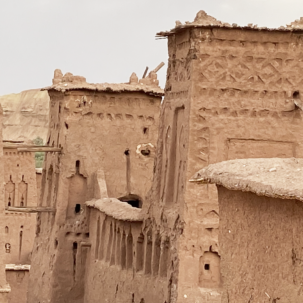



Two days and two nights at a palm grove resort in Skoura, being pampered, and reflecting on what we have experienced, so far. The palm groves surrounding Skoura itself, were originally laid out in the 12th Century by the north African Berber Muslim warrior Almohad Sultan Yacoub el-Mansour, master builder, who ruled over Seville and southern Spain and north Africa at the time of flourishing of the arts, trade, architecture, philosophy, and science.
April 20 and 21. Saturday and Sunday.
Onward to the Imperial City of Marrakech. On the way we go through the Tizi-n-Tichka Pass, a jaw-dropping rendezvous of High Atlas Mountains, with reddish-purple terrain and goat herds, woven into serene Berber villages.
Fabled Marrakech begins and ends with its heart beating an African identity into the multi-layered soul of Morocco.
In the celebrated Jemaa el Fna square, one of the largest, liveliest plazas in the world, the traditional center of commerce, trade and gossip, we will return again and again to witness snake charmers, drumming groups from Senegal, monkey handlers, a riot of color and textures, blind beggars, fortune-tellers, and every imaginable crafts vendor and farmer from north Africa.













We will visit the Medina souks (a bazaar), best known for pottery (Rue Souk Smarine), spice markets, cloth merchants overflowing with bolts of bright silks and embroidered cloth for traditional kaftans. We will encounter tailors and blacksmiths, if you have something you fancy, being custom-made. The Rahba Kédima Magic Market is unforgettable, abundant with ritual dried eagles, mountain foxes, hedgehogs, snakes, and lizards and other esoteric mysterious relics used in concoctions of love potions, stimulants, and aphrodisiacs… female magic used to balance the many parts of male-dominated aspects of Moroccan life.
A footnote: the Rahba Kédima market was previously used as the place of the old corn market. Until the 19th Century, it was forbidden to export grain, as it was considered immoral to profit by feeding Christians (in the export world) to the discomfort of poor Muslims. Through this, and many other beliefs, we will gain insights through the expertise of our cultural historic guide, Mohammed Salaheddin Lazrak.
Our time in Marrakech will also be devoted to visiting the Ben Youssef Medersa, Koranic School – a masterpiece of Moorish design where the Qur’an has been taught for generations, a spectacular sacred space, including Zellij tile work, mosaic paved corridors, and the main entrance bronze door – magnificently ornate, and capped with a carved cedar lentil and beautifully written calligraphic script.
We will also immerse ourselves in the Jewish mellah or Jewish Quarter, formerly called ‘Hay Essalam’, in the old medina, beginning at the corner of 36 Talmud Torah and Derb Francisco streets, visiting Synagogue Laazama, established in 1492, and having profound exhibits on Jewish life. We will also have time to visit the tranquil and historic Jewish cemetery with 20,000 graves. It should be noted that Morocco’s sacred Jewish sites are either UNESCO Heritage sites and/ or protected by the King and the Kingdom of Morocco government.






Twenty minutes from Marrakech on the road to Ouzarzate, is the tomb of Moulay Ighi visited by Muslims and Jews alike. Tucked away off a side road is the shrine complex of the Rabbi known as the Jewish shrine of Moulay Ighi (Master Ighi) surrounded by the grandeur of the Atlas Mountains. Jews and Muslims come from all over, making pilgrimage or hiloula, especially for Lag b’Omer, converging here on foot and on mules, visiting the Rabbi’s tomb and praying for his intervention in their lives.
Driving further south, we will visit the untouched Berber village of Ourigane, population 6,900 people, just outside the National Park, and noted for its Berber pottery and also the Jewish-Berber shrine of Rabbi Mordekhai and Rabbi Abraham Ben Hammou, with artifacts- some dating from before the 1700’s, including candlesticks, menorahs, Torah scroll crowns, and the Ten Commandments (in Hebrew) etched on a plate,
April 22-23. Monday and Tuesday.
We drive to the Atlantic coast and experience one of our favorite places, Essaouira, a former 16th Century Portuguese port and fortress deeply steeped in art and culture. Founded in the 7th Century by sea-going Phoenician traders. The 1950’s the film “Othello” by Orson Wells, was filmed there, and more recently the HBO hit “Game of Thrones” was partially filmed in Essaouira, as was “John Wick 3”.








In the medina, Bayt Dakira, we will visit The House of Memory, a living museum in the land of Islam, showcasing the historic Jewish-Muslim past of Essaouira, and its openness to the Other, and its exceptional interdependence living together for so many Centuries.
This homage to both cultures, where there were once 37 synagogues interspersed among many mosques, celebrates the art of living together in closeness, in mutual respect, was undertaken by King Mohammed VI’s adviser, André Azoulay, Moroccan-Jewish counselor to the King. His daughter, Audrey Azoulay, Director-General of the UN’s cultural agency, UNESCO, continues to actively nurture the vision.
Everywhere in Morocco, there are photographs of the current king and his father, King Hassan II, both beloved guides in crafting cross-cultural dialogue between Jews and Muslims. Audrey Azoulay, is a prominent Jewish-French politician, and her father, André, is a close personal adviser to Moroccan King Mohammed VI. “I am very comfortable as a Moroccan Jew because I belonged to a community that arrived in Morocco close to 1,000 years before Islam and the Arab civilization”, reflected André Azoulay recently.
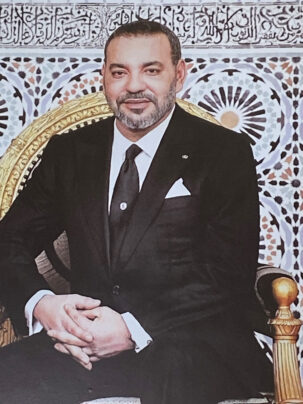
The King of Morocco

His Highness King Mohammed VI of Morocco presenting an award of honor to The Rishon Lerzion Chief Rabby of Israel, Harav Shlomo Moshe Amar during the Chief Rabbi’s Morocco visit.
His vision of establishing friendly and peaceful relations between Israel and Morocco, was realized in the 2020 Abraham Accords. His influence is evident in every area of these relations. The House of Memory visit, will ‘re-jigger’ your molecules, and your outlook on the arc of peace and living together.








The medina spills over into a spectacular harbor where we will visit artisanal fishermen and their boat-building shipyard, and take in a beautiful surfing beach with its cafés and art galleries.
One of Essaouira’s signature arts is its renowned, since antiquity, creation of inlaid wood (marquetry) cabinetry, boxes, and elaborate tables out of the storied Thuya hardwood tree. We will visit these craftspeople in their workshops, where they select and master almost every part of the Thuya Tree: the branches, the trunk, the stump, the roots, and the prized ‘gnarl’. Each with its own distinctive coloration and wood grain.
The souk bazaar markets here are among the most exuberant in all of Morocco, a maze overflowing with fruits, and produce, wooden box creations, Moroccan textiles, spectacular woven carpets and pottery, Berber clothing, tinware and finely crafted metalwork, and crafts from all over Morocco!
We will luxuriate in exploring the medina on foot, visiting artisans, including the mysterious, brightly colored tribal painted canvases inspired by myths and Berber-African culture, bargaining with vendors while enjoying mint tea, Berber and Moroccan hospitality, and tajine-prepared regional foods.
April 24. Wednesday.
We drive to Casablanca and stay in the old medina, enclosed in ancient ramparts.
We will visit the Museum of Moroccan Judaism, the only museum devoted to Judaism and Jewish life, in the Arab world. The museum, whose building originated in 1948 as a Jewish orphanage that housed up to 160 Jewish youth, was opened by King Mohammed VI of Morocco in 1916.
We will have a visit and luncheon with Rabbi David Kadoch at Casablanca’s Beit El Synagogue with time for conversation and questions and answers from the esteemed Rabbi. This intimate encounter will be followed with a visit to the Mosque of Hassan II.
The Mosque of Hassan II, one of two Mosques in all of Morocco open to non-Muslims, and one of the largest religious buildings in the world – after the Mosque in Mecca. Built between 1986-and 1993 by 35,000 artisans and craftspeople, incorporating design elements of the most sacred Mosques dating from 688 C.E. (including The Dome of The Rock and the Great Mosque of Cordova, Spain).



Tour Co-Leaders: Charles and Marla
This glorious, astonishingly brilliant venue, a treasury of accumulated Muslim sublime and sacred architecture, with gardens and 45 marble fountains decorated with zellij tilework, has the capacity to accommodate 25,000 devotees in prayer. The 656-foot-tall Minaret, the ‘lighthouse’ of Islam’, is a monument to Moroccan architectural virtuosity. Our cultural historian guide, Mohammed Salaheddin Lazrak, will share with us his knowledge of this vast sacred space and its many ritualistic and historic sacred meanings.
We will have time to stroll in the Parc de la Ligue Arabe, a vast treasure-trove garden of tall palm trees and Ficus trees laid out in 1919, café terraces, arcades and pergolas framing stunning flower beds. A place of contemplation, meditation, and journaling.
Our last evening, we will celebrate with a Farewell Dinner night in Casablanca. Next morning our group heads to the Casablanca Mohammed V International Airport, and destinations in Africa, Europe, or onward to home.
Kind regards,
Charles Simmons and Marla Perry-Simmons
charles@nulltwotruths.org • Tel: (520) 331-8338